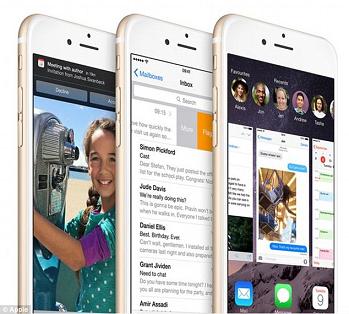If you're planning to update your iPhone or iPad to the latest iOS 8 software, you may be in for a shock.
Although the update files themselves take up less than 1GB of space, the total software needs between 3GB and 5GB of storage to complete the install, depending on how up-to-date the device is.
This means that if you don't have enough space on your device, you may need to get rid of photos, videos, files and apps just to make room.
Apple unveiled iOS 8 in June and released it worldwide on Wednesday, and although the size may seem substantial, it is average for mobile software of this kind.
Design-wise, iOS 8 looks similar to iOS 7, with flat icons and menus.
The search function on Apple's Photos app has been improved to make it easier to find photos, based on location, dates, or album name.
The Messages app in iOS 8 now lets users capture sounds to send in conversations, including voice notes, ambient sounds and music.
The new Messages app also takes on Whatsapp by additionally letting users send videos, start group conversations and enable Do Not Disturb to hide group notifications until a later time.
Elsewhere, users can send their location to friends, which appear on an interactive map, and send multiple photos and videos from the Camera Roll.
These new features need room on the device, but during the install, Apple also needs somewhere to temporarily store iOS 7 while it is being replaced.
It also needs room to unpack software files, before compressing them, which means that although the update may need a certain amount of space, the final space it occupies should be less.
Users can upgrade to the software by opening Settings, General, and selecting Software Update.
If users need to clear space on the device, they can begin by uploading their photos and files to iCloud.
If the Photo Stream feature is enabled, there may be duplicate photos in the Camera Roll and iCloud.
Once the photos are backed up, these duplicates can be removed from the Camera Roll.
Backups automatically take place when the features is enabled - in Settings, iCloud, Storage & Backup - and the device is plugged into the mains, and connected to Wi-Fi.
Files can also be transferred to a laptop or PC by connecting the phone or tablet, and dragging the photos and contacts, for example, over.
Users can also delete apps, by pressing and holding them from the homescreen and clicking the cross.
Many apps will be removed from the device, but are still accessible from iCloud.
Once the software is installed, if there is enough room, users can then re-download any apps they removed.
Be aware that when apps are deleted, typically their data is removed as well, which won't be recoverable.
In addition to deleting photos and videos, messages equally take up storage space and full, unwanted conversations should be removed to make room.
Clearing cookies used to store data on Apple's Safari browser will also make space. This can be done in Settings, Safari, Clear Cookies and select Data.
Beiruting News
Other news
-
 World News
World NewsTerry Bitar celebrated a beautiful milestone in her inspiring journey with her wedding at the majestic Cathedral La Madeleine in Paris
12 february 2025 -
 World News
World NewsLebanon's Shawarma tops list of world's best sandwiches
29 january 2025 -
 World News
World NewsNour Arida Shines at the Joy Awards in Riyadh, Celebrating Arab Artistic Achievements
19 january 2025 -
 World News
World NewsLebanese qualifier Hady Habib makes history at Australian Open
12 january 2025 -
 World News
World NewsThe Rise of DJOW Music - Joseph Daou: From Lebanon to Global Stages
10 january 2025 -
 World News
World NewsMarcelito Pomoy Releases 'The Prayer' by Italian Star Andrea Bocelli with His Blessing
25 september 2024 -
 World News
World NewsCeline Dion Will Perform at the Olympics Opening Ceremony
24 july 2024 -
 World News
World NewsYOUSRA IN TONY WARD x CANNES 2024
15 may 2024 -
 World News
World NewsCelebrities Basketball Game
14 april 2023 -
 World News
World NewsIn Video: Huge fire In the Jebel Ali region Dubai
18 october 2021 -
 World News
World NewsDubai expo 2020 in video: 8 years of work in 40 seconds
29 september 2021 -
 World News
World NewsHe can no longer stand being with his wife and asks to go to prison
25 october 2021 -
 World News
World NewsPhotographer Takes Once In Lifetime Shot Of The Moon Looking Like Saturn
18 august 2021 -
 World News
World NewsIn Video: Rare Natural Event in Alaska Sees 3 Volcanoes Erupting at The Same Time
17 august 2021 -
 World News
World NewsIn Video: Angry Bull Jumps Into Crowded Stands In Shocking Video
09 august 2021 -
 World News
World NewsIn Video: Spain battles wildfires fuelled by one of earliest heatwaves on record
20 june 2022 -
 World News
World NewsThe UAE begins implementing a water from air technology system
30 july 2021 -
 World News
World NewsIn Video: Siberia Is On Fire After Hottest And Driest Month In 133 Years
23 july 2021 -
 World News
World NewsUAE: Longer weekend and new working hours for Abu Dhabi govt departments in 2022
07 december 2021 -
 World News
World NewsIn Video: Amazon Founder Jeff Bezos Will Fly To Space Today
20 july 2021





